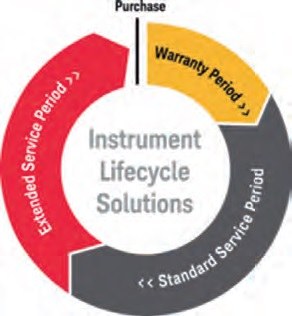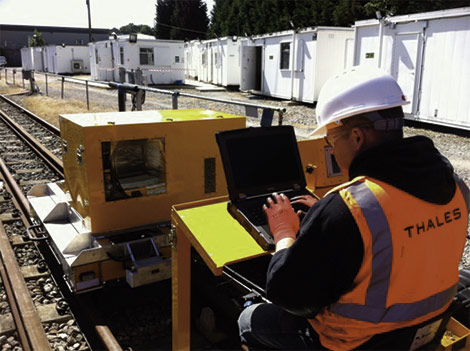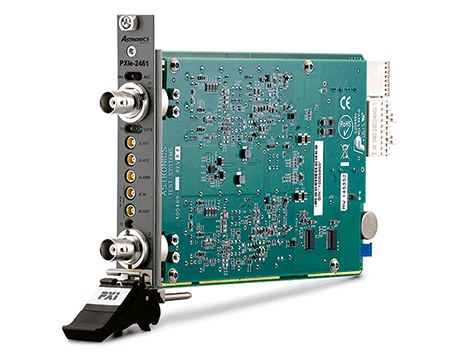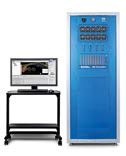At the start of every new product program, vast amounts of time, attention, and money are spent defining and integrating the necessary test system. The system is used to test new products, ensure they perform at required levels, and maintain high productivity. The system is also expected to last the lifetime of the program.
Carefully designed test systems help ensure high-quality results and maximum throughput. Over time, variable test results can affect quality, and equipment downtime results in costly delays. In recent years, changes in parts availability and dealer support have added to these challenges. Fortunately, administrators can mitigate these risks and keep their programs running with an experienced solution partner. As an original manufacturer (OEM), Keysight offers efficient and effective alternatives that can extend the life of test systems and ensure that each instrument meets its warranted specifications. Some examples include Keysight's Extended Service Period (ESP) solutions for calibration and repair. These constitute the company's commitment to the installed base of our customers' older HP, Agilent and Keysight equipment. Through standard and custom ESP solutions, Keysight helps our clients keep long-term programs running until they are ready to transition to new technology. ESP solutions are part of a larger initiative called Keysight Instrument Lifecycle Solutions (ILS). These solutions, better defined as a commitment to business continuity, respond to service requirements that span the entire life cycle of the customer's product (figure 1). Through these solutions, Keysight helps ensure system longevity, from the very date of initial purchase well into the future. Around the figure, warranty period solutions include our standard three-year warranty, as well as the ability to guarantee that level of coverage for up to 10 years. Standard Service Period (SSP) solutions ensure continued performance, after warranty, by delivering Keysight's quality service—in calibration and repair—that optimizes customer budgets and improves instrument uptime. Extended Service Period solutions cover essential equipment after product manufacturing is complete, giving customers more time to make a smooth transition to new technology.
Understanding the OEM dilemma
There is an unavoidable paradox in supporting older test equipment. Early in the system life cycle, OEMs can provide strong support; however, new instruments typically require much less support than older equipment. The need for support increases as instruments age, but an OEM's support capabilities typically decline as products are discontinued, spare parts are available, and technical skills are lost (Figure 1). The underlying cause is the natural life cycle of any commercial product: introduction, growth, maturity, and decline (figure 2). Each product progresses at a different rate, driven by external factors: customer acceptance, competition from other manufacturers, general economic conditions, and so on. As demand declines, OEMs often introduce new products to replace older models, requiring new investments in manufacturing, parts, and know-how. As the product ages, the OEM must make trade-offs and decisions regarding the allocation of scarce resources devoted to manufacturing and support. Maintaining an old product consumes resources that could be used to develop new products based on the latest technologies (Figure 3). One of the reasons for the change in the allocation of resources is the expectation of greater return for the money invested in a new product. Savvy OEMs do this in a way that meets the needs of existing customers by providing compatibility modes, long lead-times for discontinuation notification, and extended service capabilities. The most difficult scenario is that of an aerospace or defense (A/D) program, for which a duration that can be as long as 15 or 25 years can be expected. In general, the life cycle of a commercial product is much shorter than that of an A/D program (figure 4). This creates a temporary problem: on many occasions, the instruments in a test system have already passed their peak demand and begin to decline by the time the A/D program reaches its peak. When the A/D program experiences growth and then gradually declines, the OEM's next generation of products is in the growth phase (see Figure 3). The availability of spare parts is another important factor. An instrument, such as a microwave signal analyzer, contains thousands of individual components made by hundreds of vendors. Each piece has its own life cycle, from its presentation until it is no longer manufactured. External forces, such as changes in government regulations (eg. (e.g. RoHS compliance) may also affect parts availability.
Extend the life of a test system
All of the above provides context, but it is still possible to create an effective strategy that adds years to the life of a test system. The best opportunity to plan and execute this strategy is at the time of the original purchase. If you have missed this opportunity, there is still time while the instruments are in production. Even if the instruments are discontinued, there are ways to extend the life of the system.
At the time of purchase (warranty period)
As noted above, A/D systems can last 15 years or more. When defining a test system and evaluating the available instruments, it is worth considering a few key questions: • How long has the OEM been in business? o What is the probability that it will still be there in about 20 years? • To what extent do they listen to your needs? o Do they respond with proposals that make sense from a technical perspective? o Do your suggestions make sense from a business perspective? • Can the OEM support your program in the long term by supplying the necessary system components? o Do they offer cost-effective insurance plans and maintenance services? o Do you have a service infrastructure designed to meet present and future needs? • What is the true cost of doing business with the vendor, now and throughout the lifetime of the test system? o How long is your standard warranty? The higher the number of favorable answers, the better the chances that a provider can guarantee that a system will work at full capacity in the future.
During production and while spare parts (SSP) are available
While an instrument is being manufactured, OEM support capabilities are relatively high. Now is a good time to adopt best practices, such as using quality services and developing contingency plans for the post-manufacturing phase. Strong contingency planning starts with a key premise: OEM support capabilities gradually diminish over time. It is best to work directly with the OEM to determine long-term plans and needs. For example, it is wise to regularly monitor product life cycles and determine the value of life cycle purchases for all critical components. The OEM must be willing to help ensure a sufficient inventory of parts or spares to prevent critical failures. It is also the best time to identify critical instruments and purchase an optimal number of spare parts based on statistical data such as mean time between failures. Creating and maintaining intra- and intercompany asset lists can reveal available spare parts and also avoid unnecessarily throwing away items that are still needed.
Once the products have been discontinued (ESP)
Ultimately, an organization will have to deal with the support and maintenance of discontinued instruments. At this point, there are three options: OEM services, third-party services, and self-maintenance. Although the best option depends on the technical and business specifics of the situation, the OEM will generally provide a higher quality service than an external provider or their own in-house maintenance staff. One reason: providing excellent service ensures customer satisfaction and, by being pragmatic, helps protect the company's reputation. Also, because they are aware of the need for long-term support, some OEMs have it planned on a product-by-product basis. This requires an investment in the necessary infrastructure: people, equipment, test systems and the supply chain of original OEM parts. Another option is to purchase second-hand equipment to use as spare parts for damaged instruments. This can be helpful if the following are true regarding the used equipment: • Any necessary repairs have been performed by factory-trained technicians. • Where necessary, only original OEM parts have been used. • After any repair, the instrument has undergone a full calibration and all necessary adjustments. Similar to the suggestions above, we recommend buying used equipment that has been fully refurbished by the original manufacturer.
Conclusion
When our customers evaluate service alternatives, they can have confidence in Keysight's ability to ensure their business continuity. We know it takes time to find the right equipment and a trusted solution partner. Once the test system is up and running, the responsible organization needs to be confident that it will continue to work. That's why we offer solutions for the entire instrument life cycle, including our Extended Service Period solutions.







